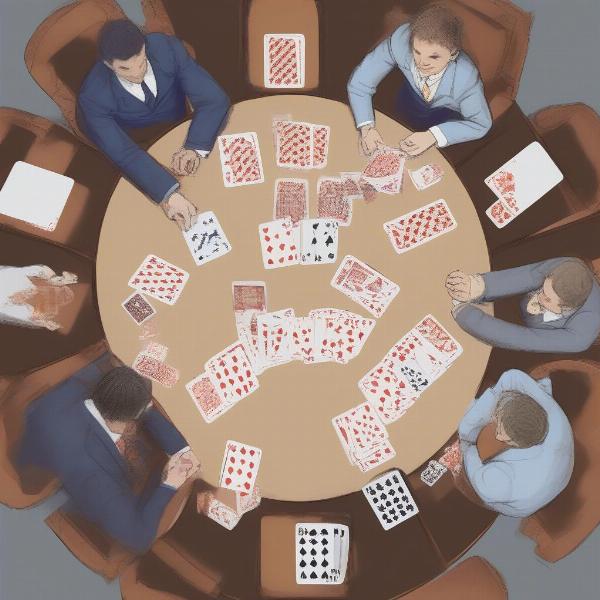Pitch, also known as Setback or High Low Jack, is a trick-taking card game popular for its simple rules yet strategic gameplay. It’s a great game for small groups and can be enjoyed by players of all ages. Whether you’re a seasoned card shark or a complete beginner, this guide will equip you with everything you need to know to play Pitch.
Similar to how long is a professional soccer game, Pitch can vary in duration depending on the number of players and the target score. Let’s dive into the basics.
Understanding the Basics of Pitch
Pitch uses a standard 52-card deck. The number of players typically ranges from two to four, but variations exist for up to six. The game revolves around bidding, winning tricks, and scoring points based on specific cards and achievements.
Dealing the Cards
Each player is dealt six cards. The remaining cards form the stock pile. Dealing usually rotates clockwise after each hand.
Bidding
Bidding determines the trump suit for the hand. Players bid based on how confident they are in winning certain point cards or achieving specific combinations. The minimum bid is usually two, and bidding continues clockwise until a bid is accepted by all other players. A player can also pass, indicating they don’t wish to bid.
Playing the Hand
The player who wins the bid leads the first trick. Players must follow suit if possible. If a player cannot follow suit, they can play any card, including a trump card. The highest card of the led suit wins the trick, unless a trump card is played, in which case the highest trump card wins.
Scoring
Points are awarded for winning specific cards and combinations within the tricks. The most common scoring cards are the ten (10 points), Ace (4 points), King (3 points), Queen (2 points), and Jack (1 point). Other points can be earned for achieving the “high,” “low,” “jack,” and “game.” The “game” is the total value of cards won in tricks, usually counted as one point.
 Dealing Cards in Pitch
Dealing Cards in Pitch
Advanced Strategies for Pitch
Mastering Pitch requires more than just understanding the basic rules. Here are some advanced strategies that can elevate your game.
Strategic Bidding
Don’t overbid! Accurately assess your hand’s strength before bidding. Consider the point cards you hold, potential trump combinations, and the game point. Sometimes, a conservative bid is better than risking a loss.
Trump Management
If you win the bid and choose the trump suit, use your trump cards wisely. Don’t waste them on low-value tricks. Save them for securing high-point cards or winning crucial tricks later in the hand.
Observing Opponents
Pay attention to the cards played by your opponents. This will give you clues about their hand strength and what cards they might be holding. Observing discards can also provide valuable information. Just like when considering whether are any cardinals in the all star game, observing individual player performance is key in Pitch.
 Playing a Hand of Pitch
Playing a Hand of Pitch
Variations of Pitch
Pitch has several variations, each adding unique twists to the gameplay. Some popular variations include:
- Partnership Pitch: Played with four players in teams of two. Partners sit opposite each other and work together to achieve the highest combined score.
- Blind Bid Pitch: Players bid before looking at their hands, adding an element of risk and excitement.
- Low Ball Pitch: The lowest point total wins instead of the highest.
Knowing how long is a little league game can help you appreciate the quicker pace of a Pitch card game, especially if you have limited time.
Choosing the Right Variation
The best variation for you depends on your preferences and the number of players. Experiment with different versions to find your favorite.
FAQs About Playing Pitch
Here are answers to some frequently asked questions:
- What is the minimum bid in Pitch? Typically, the minimum bid is two.
- Can you bid less than the previous bid? No, bids must always increase.
- What happens if no one bids? The hand is usually redealt.
- How many points are needed to win? The winning score varies, but it’s often seven or eleven.
- Can you play Pitch with more than four players? Yes, some variations accommodate up to six players.
- What is the “game” point? The “game” point represents the total value of cards captured during the tricks.
- Is Pitch a difficult game to learn? No, the basic rules are simple to pick up, but mastering strategy takes time.
 Scoring in Pitch
Scoring in Pitch
Beyond the Basics: Mastering Pitch Strategy
While knowing the rules is essential, mastering Pitch involves strategic thinking and adapting to different situations. “In Pitch, understanding the value of each card and its potential impact on the game is crucial for success,” says renowned card game expert, Sarah Johnson.
Observing opponents’ plays, managing your trump cards, and making calculated bids are key elements to winning consistently. Remember, like in many card games, bluffing can be a powerful tool, especially when it comes to bidding. “A well-placed bluff can deceive your opponents and lead them to make costly mistakes,” adds Johnson.
Are you eager to learn more about the gaming world? Check out when is spider man 2 game coming out for exciting news on upcoming releases.
Pitch: A Game for Everyone
Pitch is a classic card game that offers a blend of simplicity and strategic depth. Its adaptable rules and various game modes make it suitable for all types of players. Whether you’re looking for a quick game with friends or a challenging competition, Pitch provides an engaging experience that is sure to entertain.
Pitch, much like determining do yellow cards carry over to the next game, has specific rules that govern its gameplay. Give it a try and see why it remains a beloved card game across generations. Remember to practice regularly, experiment with different strategies, and most importantly, have fun!

